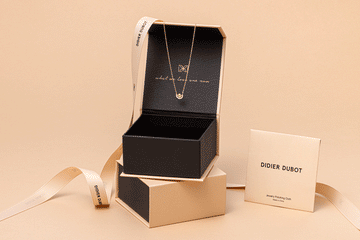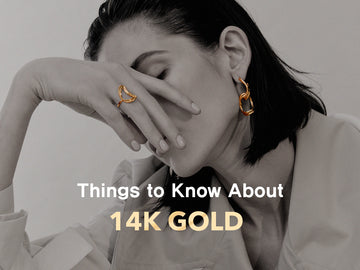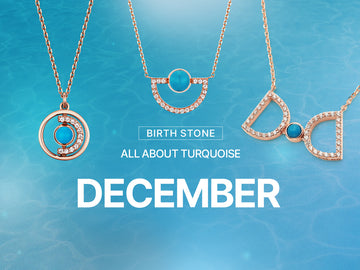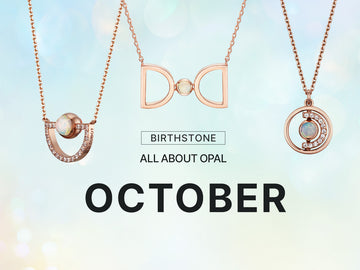Gold has always been a symbol of luxury and wealth. It’s been around since the beginning of time and is still one of the most desired materials in the world. It’s no surprise that most of us want to choose gold when shopping for high quality jewelry, but it’s important to do your research beforehand. There are many misconceptions about what quality gold really is. Read on to learn all about 14K gold so you can make the best choice.
What Does Karat Gold Mean?
If you’ve ever shopped for gold jewelry, you’ve probably noticed descriptions like ‘14K gold’ or ‘18K gold’. This stands for karat, the purity measurement for gold. It can often be confused with carat, the weight measurement for diamonds.
Many people assume that all gold jewelry is made with pure gold. In reality, pure gold (or 24K gold) jewelry isn’t very common. We know what you’re thinking: gold is a precious and valuable material. Why would jewelers want to dilute it? The explanation is simple. Pure gold is soft and prone to scratches. It’s not strong enough to withstand the wear-and-tear of everyday life, especially in items like rings and bracelets. You may encounter ceremonial jewelry made of pure gold, but these pieces are only meant to be worn for short periods of time. 24K gold is also very expensive; it’s almost double the price of 14K gold! It’s a good choice for investing or selling, but when it comes to jewelry it’s best to stick to lower karats.
There are four common purity levels when it comes to gold jewelry: 10K, 14K, 18K, and 24K. We’ve learned that 24K means 100% gold, but the other levels are blended with metal alloys. This is necessary to increase strength, create a resistance to corrosion and rust, and prevent tarnishing.
- 18K has composition of 75% gold
- 14K has a composition of 58.3% gold
- 10K is more alloy than gold, with a composition of 41.7% gold
A higher percentage of gold may seem like the best choice, but contrary to popular belief a higher karat count doesn’t necessarily indicate better quality. Each level has its own set of advantages and disadvantages.
The Benefits Of 14K Gold

14K gold is one of the most popular compositions for jewelry. It shares the beautiful appearance of 18K gold, but is more affordable, durable, and resistant to scratches. It offers the perfect balance of luxury and strength, which is why it’s a universal favorite for engagement rings, eternity bands, pendants, and other pieces of fine jewelry.
18K gold may seem like a more luxurious choice as it has a higher content of gold, but this comes with a downside. Of all the gold purity levels, 18K is the most prone to scratches. On the plus side, it’s the least likely to tarnish. With the lowest content of pure gold, 10K gold is the most durable and affordable option.
Which Type Of Gold Is Right For You?

14K gold comes in three color options: white, yellow, or rose. Each color has a slightly different composition, but all are made with quality and strength in mind. Choosing which color is right for you simply comes down to personal preference.
14K yellow gold is blended with metals like zinc and copper. Its warm tone tends to complement darker skin tones. Yellow gold is the best option for those with sensitive skin, as its composition usually doesn’t contain metals that cause irritation. It’s also the easiest color to maintain over time, although it does require regular polishing and cleaning. The biggest drawback of yellow gold is that it’s the most susceptible to scratches.
White gold is composed of a mixture of white metals like silver, nickel, and palladium. It’s finished off with a rhodium coating, creating a color that looks identical to platinum. This cool tone tends to look best on fair skin tones. White gold alloys tend to be stronger than yellow gold alloys, making white gold more resistant to scratches. White gold jewelry should be professionally dipped every few years to retain color and luster, as well as renewing the rhodium coating. The only downside to white gold is that the alloy often contains nickel, which is not hypoallergenic.
Rose gold is made with a copper alloy that gives rose gold its lovely pink color. The flattering rosy hue complements all skin tones. Copper also provides the highest level of durability of the three golds, as it is a strong metal. It’s also inexpensive compared to the metals used in yellow and white gold, so rose gold tends to be the most affordable option. Unfortunately copper is not hypoallergenic, so rose gold may not be the best choice for those with sensitive skin.
No matter what color you choose, 14K gold is always an excellent choice for jewelry.
Shop DIDIER DUBOT’s collection of genuine 14K gold jewelry today.
Writer: Maria Polansky

















